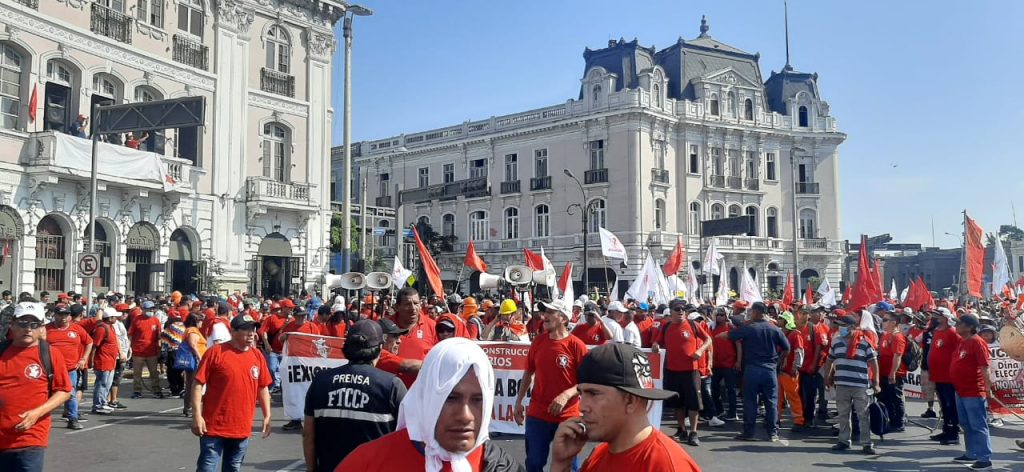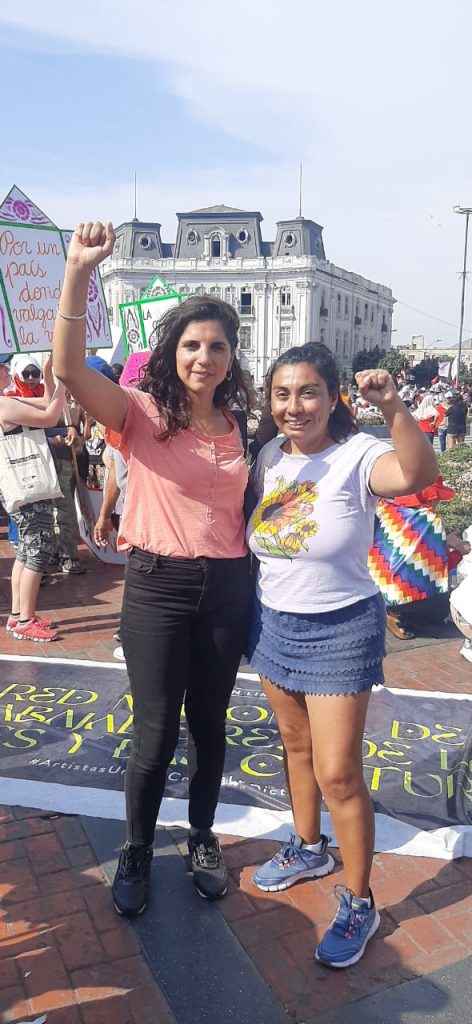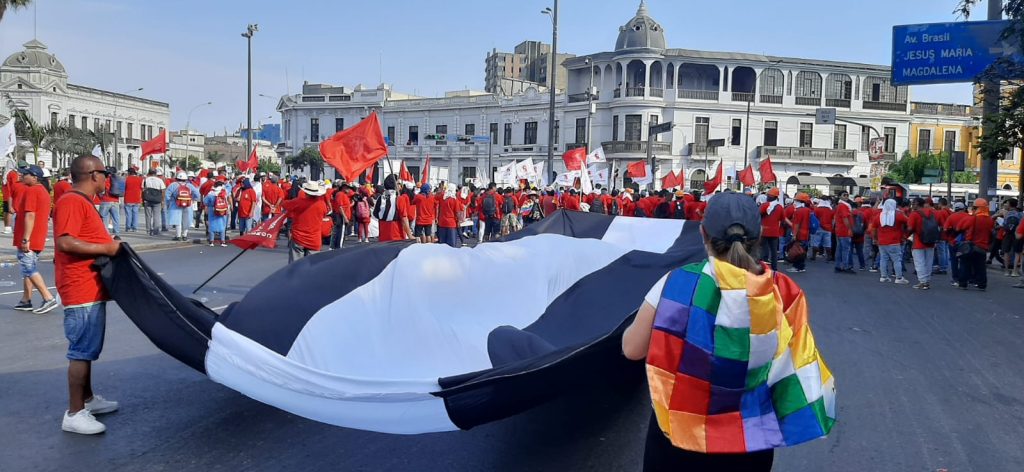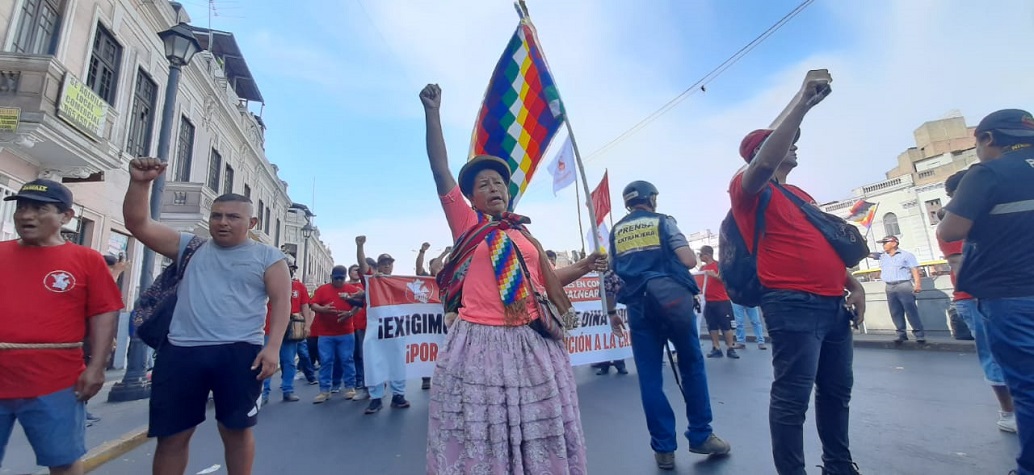Por Sofía Martínez Guerrero
En el contexto de lucha nacional, el 9 de febrero se desarrolló una multitudinaria movilización en Lima, en el marco del paro nacional convocado por la CGTP que se le arrancó producto de la lucha de dos meses que llevan trabajadores, campesinos y el pueblo en general contra el gobierno ilegítimo de Boluarte.
Desde julio de 1977 la central sindical no convocaba ni a paro nacional ni a ninguna acción significativa de protesta, pese a los continuos emplazamientos de organizaciones sindicales, sociales y políticas. Estos dos meses de gobierno golpista y brutal represión hizo que la presión social y de sus bases, como así también la persecución y detención de dirigentes sindicales, arrancaran esta convocatoria a la burocracia de la CGTP.
La concentración comenzó en la plaza Dos de Mayo, donde está situado el local histórico de la CGTP. Con el correr de las horas fueron llegando delegaciones sindicales y regionales. A partir de las 4 pm se inició la marcha, con fuerte presencia sindical. Los sindicatos de construcción civil estuvieron a la cabeza con las delegaciones más numerosas, y también estuvieron presentes sectores de telefónicos, maestros, metalúrgicos, tiendas por departamentos, trabajadores de embotelladoras, entre otros.

Por otro lado los frentes de defensa regionales participaron con las delegaciones de los distintos departamentos del Perú, con una significativa presencia del departamento de Puno. Y la delegación de Juliaca realizó una intervención artística para representar a los muertos y heridos durante la represión del 9 de enero, con personas manchas con sangre y féretros negros, que apostaron en la pista de la Av. Abancay.
La movilización, que recorrió el centro de Lima y tuvo su reflejo en las regiones de todo el país, se realizó cuando se cumplía un mes de la Masacre de Juliaca, la cual tuvo un saldo mortal de 18 personas asesinadas. Al día de hoy no hay avance en el proceso de investigación y la lucha por justicia sigue más presente que nunca.
El paro en las regiones
En el sur del Perú se vienen sosteniendo los bloqueos de carreteras desde hace 2 meses. Cusco sigue con la actividad turística paralizada. En Ollantaytambo se suma a las protestas con el tren bloqueado. Apurímac y Sierra Central los bloqueos de carreteras del corredor minero permanecen, lo mismo en Arequipa, Moquegua y Puno. En regiones como Ayacucho, Huancavelica y Tacna se realizaron movilizaciones de apoyo al paro. Asimismo, en horas de la tarde se reportaron violentas represiones por parte de la policía en Apurímac y Puno.
En San Roman (Puno), la represión dejó un saldo de 23 heridos, y a pesar de la brutalidad de la policía, se logró mantener la toma en el puente Desaguadero en el límite con Bolivia, que lleva 2 meses.
En Aymaraes (Apurímac), la represión dejó 3 heridos graves y la muerte de un jóven de 22 años. El certificado de necropsia detalla que su muerte es por impacto de bala en el tórax.
Desde hace dos semanas diversas organizaciones de DDHH denuncian que tanto Puno, Ayacucho y Selva Madre de Dios están militarizadas, y con acciones de intimidación permanentes contra el conjunto de la población.
Los departamentos del norte de Perú, enviaron a Lima delegaciones que se sumaron a las protestas, como La Libertad, Ancash, Chiclayo, Piura, Cajamarca, Tumbes, entre otros. La macro regional norte ha acordado realizar un paro del 17 al 20 de febrero, afectando la actividad comercial, el abastecimiento de alimentos como así también el transporte.
El gobierno golpista sigue mirando para otro lado
Boluarte sigue burlándose de los que luchan. En una conferencia de prensa volvió a referirse a quienes se movilizan como una “minoría” y sale a exponer sus “avances” de gestión sin reconocer los asesinatos que han cometido contra el pueblo movilizado. Se desligó de la represión y las detenciones que lleva adelante la policía, y sigue usando su condición de mujer para victimizarse.
Además, es tal la inoperancia de este gobierno ilegítimo, que no tardaron en llegar las denuncias de la falta de respuesta ante el huaico en Secocha (Arequipa) donde hay más de 3 mil damnificados que lo han perdido todo.
No solo reprime y mata al pueblo movilizado, sino que no da respuesta a la situación urgente que padecen miles de familias.



Mantener el paro e intensificar la lucha hasta que se vaya Boluarte
Este paro nacional es consecuencia de la lucha que venimos llevando adelante hace dos meses, hoy la tarea es mantener el paro, avanzar a una huelga general indefinida. Hay que seguir sumando la mayor participación de todos los sectores. Los estudiantes deben aumentar aún su participación. Otros gremios de magisterio, los colectivos y organizaciones sociales necesitamos que se sumen con más fuerza a la lucha.
Hace falta una coordinación unitaria para dar la pelea. Hay que seguir sumando solidaridad y apoyo a la lucha.
Una coordinación de todos los que estamos luchando, enfrentando la represión en las calles, denunciando al gobierno golpistas y a esta dictadura cívico militar. Las organizaciones de la izquierda revolucionaria tenemos que trabajar de forma unitaria con las organizaciones de trabajadores, campesinos, para avanzar en la lucha por derrotar y echar a Boluarte y asumir el gobierno. La movilización y la organización desde abajo es nuestra garantía. Es la única garantía para luego hacer el llamado a la Asamblea constituyente, que tiene que ser libre y soberana, para que de una vez por todas la prioridad sea nuestro pueblo y no los burócratas, corruptos y golpistas.




